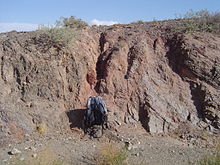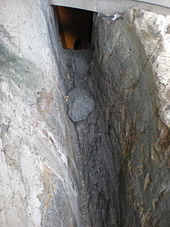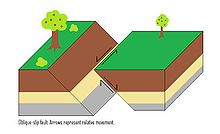
Fault (geology)
Background to the schools Wikipedia
SOS believes education gives a better chance in life to children in the developing world too. SOS Children has looked after children in Africa for forty years. Can you help their work in Africa?
In geology, a fault is a planar fracture or discontinuity in a volume of rock, across which there has been significant displacement along the fractures as a result of earth movement. Large faults within the Earth's crust result from the action of plate tectonic forces, with the largest forming the boundaries between the plates, such as subduction zones or transform faults. Energy release associated with rapid movement on active faults is the cause of most earthquakes, such as occurs on the San Andreas Fault, California.
A fault line is the surface trace of a fault, the line of intersection between the fault plane and the Earth's surface.
Since faults do not usually consist of a single, clean fracture, geologists use the term fault zone when referring to the zone of complex deformation associated with the fault plane.
The two sides of a non-vertical fault are known as the hanging wall and footwall. By definition, the hanging wall occurs above the fault plane and the footwall occurs below the fault. This terminology comes from mining: when working a tabular ore body, the miner stood with the footwall under his feet and with the hanging wall hanging above him.
Mechanics

Because of friction and the rigidity of the rock, the rocks cannot glide or flow past each other. Rather, stress builds up in rocks and when it reaches a level that exceeds the strain threshold, the accumulated potential energy is dissipated by the release of strain, which is focused into a plane along which relative motion is accommodated—the fault.
Strain is both accumulative and instantaneous depending on the rheology of the rock; the ductile lower crust and mantle accumulates deformation gradually via shearing, whereas the brittle upper crust reacts by fracture - instantaneous stress release - to cause motion along the fault. A fault in ductile rocks can also release instantaneously when the strain rate is too great. The energy released by instantaneous strain release causes earthquakes, a common phenomenon along transform boundaries.
Microfracturing and Accelerating Moment Release (AMR) theory

Microfracturing, or microseismicity, is often thought of as a symptom caused by rocks under strain, where small-scale failures, perhaps on areas the size of a dinner plate or a smaller area, release stress under high strain conditions. Only when sufficient microfractures link up into a large slip surface can a large seismic event or earthquake occur.
According to this theory, after a large earthquake, the majority of the stress is released and the frequency of microfracturing is exponentially lower. A connected theory, accelerating moment release (AMR), claims that the seismicity rate accelerates in a well-behaved way prior to major earthquakes, and that it might provide a helpful tool for earthquake prediction on the scale of days to years.
AMR may be used to predict rock failures within mines, and applications are being attempted for the portions of faults within brittle rheological conditions. Researchers observe like behaviour in tremors preceding volcanic eruptions.
Slip, heave, throw

Slip is defined as the relative movement of geological features present on either side of a fault plane, and is a displacement vector. A fault's sense of slip is defined as the relative motion of the rock on each side of the fault with respect to the other side. In measuring the horizontal or vertical separation, the throw of the fault is the vertical component of the dip separation and the heave of the fault is the horizontal component, as in "throw up and heave out".
The vector of slip can be qualitatively assessed by studying the fault bend folding, i.e., the drag folding of strata on either side of the fault; the direction and magnitude of heave and throw can be measured only by finding common intersection points on either side of the fault (called a piercing point). In practice, it is usually only possible to find the slip direction of faults, and an approximation of the heave and throw vector.
Fault types

Geologists can categorize faults into three groups based on the sense of slip:
- a fault where the relative movement (or slip) on the fault plane is approximately vertical is known as a dip-slip fault
- where the slip is approximately horizontal, the fault is known as a transcurrent or strike-slip fault
- an oblique-slip fault has non-zero components of both strike and dip slip.
For all naming distinctions, it is the orientation of the net dip and sense of slip of the fault which must be considered, not the present-day orientation, which may have been altered by local or regional folding or tilting.
Dip-slip faults

Dip-slip faults can occur either as "reverse" or as "normal" faults. A normal fault occurs when the crust is extended. Alternatively such a fault can be called an extensional fault. The hanging wall moves downward, relative to the footwall. A downthrown block between two normal faults dipping towards each other is called a graben. An upthrown block between two normal faults dipping away from each other is called a horst. Low-angle normal faults with regional tectonic significance may be designated detachment faults.
A reverse fault is the opposite of a normal fault—the hanging wall moves up relative to the footwall. Reverse faults indicate shortening of the crust. The dip of a reverse fault is relatively steep, greater than 45°.
A thrust fault has the same sense of motion as a reverse fault, but with the dip of the fault plane at less than 45°. Thrust faults typically form ramps, flats and fault-bend (hanging wall and foot wall) folds. Thrust faults form nappes and klippen in the large thrust belts. Subduction zones are a special class of thrusts that form the largest faults on Earth and give rise to the largest earthquakes.
The fault plane is the plane that represents the fracture surface of a fault. Flat segments of thrust fault planes are known as flats, and inclined sections of the thrust are known as ramps. Typically, thrust faults move within formations by forming flats, and climb up section with ramps.
Fault-bend folds are formed by movement of the hanging wall over a non-planar fault surface and are found associated with both extensional and thrust faults.
Faults may be reactivated at a later time with the movement in the opposite direction to the original movement (fault inversion). A normal fault may therefore become a reverse fault and vice versa.
Strike-slip faults
The fault surface is usually near vertical and the footwall moves either left or right or laterally with very little vertical motion. Strike-slip faults with left-lateral motion are also known as sinistral faults. Those with right-lateral motion are also known as dextral faults.
A special class of strike-slip faults is the transform fault, where such faults form a plate boundary. These are found related to offsets in spreading centers, such as mid-ocean ridges, and less commonly within continental lithosphere, such as the Alpine Fault, New Zealand. Transform faults are also referred to as conservative plate boundaries, as lithosphere is neither created nor destroyed.
Oblique-slip faults
A fault which has a component of dip-slip and a component of strike-slip is termed an oblique-slip fault. Nearly all faults will have some component of both dip-slip and strike-slip, so defining a fault as oblique requires both dip and strike components to be measurable and significant. Some oblique faults occur within transtensional and transpressional regimes, others occur where the direction of extension or shortening changes during the deformation but the earlier formed faults remain active.
The hade angle is defined as the complement of the dip angle; it is the angle between the fault plane and a vertical plane that strikes parallel to the fault.
Listric fault
A listric fault is a type of fault in which the fault plane is curved. The dip of the fault plane becomes shallower with increased depth and may flatten into a sub-horizontal décollement.
Ring fault
Ring faults are faults that occur within collapsed volcanic calderas. Ring faults may be filled by ring dikes.
Fault rock


All faults have a measurable thickness, made up of deformed rock characteristic of the level in the crust where the faulting happened, of the rock types affected by the fault and of the presence and nature of any mineralising fluids. Fault rocks are classified by their textures and the implied mechanism of deformation. A fault that passes through different levels of the lithosphere will have many different types of fault rock developed along its surface. Continued dip-slip displacement tends to juxtapose fault rocks characteristic of different crustal levels, with varying degrees of overprinting. This effect is particularly clear in the case of detachment faults and major thrust faults.
The main types of fault rock include:
- Cataclasite - a fault rock which is cohesive with a poorly developed or absent planar fabric, or which is incohesive, characterised by generally angular clasts and rock fragments in a finer-grained matrix of similar composition.
- Tectonic or Fault breccia - a medium- to coarse-grained cataclasite containing >30% visible fragments.
- Fault gouge - an incohesive, clay-rich fine- to ultrafine-grained cataclasite, which may possess a planar fabric and containing <30% visible fragments. Rock clasts may be present
- Clay smear - clay-rich fault gouge formed in sedimentary sequences containing clay-rich layers which are strongly deformed and sheared into the fault gouge.
- Mylonite - a fault rock which is cohesive and characterized by a well developed planar fabric resulting from tectonic reduction of grain size, and commonly containing rounded porphyroclasts and rock fragments of similar composition to minerals in the matrix
- Pseudotachylite - ultrafine-grained vitreous-looking material, usually black and flinty in appearance, occurring as thin planar veins, injection veins or as a matrix to pseudoconglomerates or breccias, which infills dilation fractures in the host rock.
Impacts on structures and people
In geotechnical engineering a fault often forms a discontinuity that may have a large influence on the mechanical behaviour (strength, deformation, etc.) of soil and rock masses in, for example, tunnel, foundation, or slope construction.
The level of a fault's activity can be critical for (1) locating buildings, tanks, and pipelines and (2) assessing the seismic shaking and tsunami hazard to infrastructure and people in the vicinity. In California, for example, new building construction has been prohibited directly on or near faults that have moved within the Holocene Epoch (the last 11,000 years) (Hart and Bryant, 1997). Also, faults that have shown movement during the Holocene plus Pleistocene Epochs (the last 2.6 million years) may receive consideration, especially for critical structures such as power plants, dams, hospitals, and schools. Geologists assess a fault's age by studying soil features seen in shallow excavations and geomorphology seen in aerial photographs. Subsurface clues include shears and their relationships to carbonate nodules, translocated clay, and iron oxide mineralization, in the case of older soil, and lack of such signs in the case of younger soil. Radiocarbon dating of organic material buried next to or over a fault shear is often critical in distinguishing active from inactive faults. From such relationships, paleoseismologists can estimate the sizes of past earthquakes over the past several hundred years, and develop rough projections of future fault activity.





